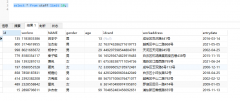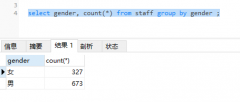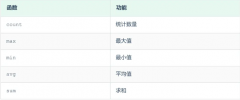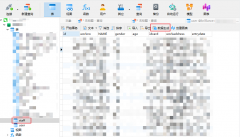XML nodes with SQL(带有 SQL 的 XML 节点)
问题描述
我有以下 XML 数据,并希望按如下方式在 KS 中获取数据:
I have the following XML data and would like to get data inside KS as row as follows:
<DW>
<KS>
<KeyInfo Name="IlluSetting">
<KeyTypeValue>Text</KeyTypeValue>
<ValueString>yDipol90</ValueString>
</KeyInfo>
<KeyInfo Name="IlluSetting2">
<KeyTypeValue>Text</KeyTypeValue>
<ValueString>yDipol</ValueString>
</KeyInfo>
</KS>
<MDESC>Tx [mrad]</MDESC>
<MNUMBER>0.12102</MNUMBER>
</DW>
<DW>
<KS>
<KeyInfo Name="IlluSetting3">
<KeyTypeValue>Text</KeyTypeValue>
<ValueString>yDipol80</ValueString>
</KeyInfo>
</KS>
<MDESC>Ty [mrad]</MDESC>
<MNUMBER>0.12102</MNUMBER>
</DW>
有什么办法可以得到一个具有以下输出的表格:
Is there any way to get a Table with the following output:
Name ValueString Name ValueString
-----------------------------------------------------------
IlluSetting yDipol90 IlluSetting2 yDipol
IlluSetting3 yDipol80
表示<KS>...</KS>里面的数据会排成一行显示
which means that the data inside <KS>... </KS> will be shown in a row
非常感谢
推荐答案
请尝试以下解决方案.我们在这里所做的称为粉碎,即将 XML 转换为矩形/关系格式.
Please try the following solution. What we are doing here is called shredding, i.e. converting XML into rectangular/relational format.
我正在拍摄,因为没有提供DDL 和样本数据群.
I am shooting from the hip because DDL and sample data population were not provided.
由于缺少根元素,提供的 XML 格式不正确,但 SQL Server 允许处理 XML 片段.
The provided XML is not well-formed due to missing root element, but SQL Server allows to handle XML fragments.
我们正在使用 XQuery 及其 .nodes() 和 .value() 方法.
We are using XQuery and its .nodes() and .value() methods.
SQL,方法 #1
-- DDL and sample data population, start
DECLARE @xml XML =
N'<DW>
<KS>
<KeyInfo Name="IlluSetting">
<KeyTypeValue>Text</KeyTypeValue>
<ValueString>yDipol90</ValueString>
</KeyInfo>
<KeyInfo Name="IlluSetting2">
<KeyTypeValue>Text</KeyTypeValue>
<ValueString>yDipol</ValueString>
</KeyInfo>
</KS>
<MDESC>Tx [mrad]</MDESC>
<MNUMBER>0.12102</MNUMBER>
</DW>
<DW>
<KS>
<KeyInfo Name="IlluSetting3">
<KeyTypeValue>Text</KeyTypeValue>
<ValueString>yDipol80</ValueString>
</KeyInfo>
</KS>
<MDESC>Ty [mrad]</MDESC>
<MNUMBER>0.12102</MNUMBER>
</DW>';
-- DDL and sample data population, end
SELECT c.value('KeyInfo[1]/@Name', 'VARCHAR(30)') AS name1
, c.value('(KeyInfo[1]/ValueString/text())[1]', 'VARCHAR(30)') AS ValueString1
, COALESCE(c.value('KeyInfo[2]/@Name', 'VARCHAR(30)'), '') AS name2
, COALESCE(c.value('(KeyInfo[2]/ValueString/text())[1]', 'VARCHAR(30)'), '') AS ValueString2
FROM @xml.nodes('/DW/KS') AS t(c);
输出
+--------------+--------------+--------------+--------------+
| name1 | ValueString1 | name2 | ValueString2 |
+--------------+--------------+--------------+--------------+
| IlluSetting | yDipol90 | IlluSetting2 | yDipol |
| IlluSetting3 | yDipol80 | | |
+--------------+--------------+--------------+--------------+
SQL,方法 #2
DECLARE @CrLf CHAR(2) = CHAR(13) + CHAR(10)
, @tokenCounter INT
, @i INT = 1;
-- Calculate max number of tokens in the <KS>
SET @tokenCounter = (SELECT MAX(c.value('count(KeyInfo)', 'INT'))
FROM @xml.nodes('/DW/KS') AS t(c));
DECLARE @SQL NVARCHAR(MAX) = 'SELECT ';
WHILE @i <= @tokenCounter BEGIN
SET @SQL += IIF(@i>1,', ','') + 'COALESCE(c.value(''KeyInfo[' + CAST(@i AS VARCHAR(3)) + ']/@Name'', ''VARCHAR(30)''), '''') AS NAME' + CAST(@i AS VARCHAR(3)) + @CrLf
SET @SQL += ', COALESCE(c.value(''(KeyInfo[' + CAST(@i AS VARCHAR(3)) + ']/ValueString/text())[1]'', ''VARCHAR(30)''), '''') AS ValueString' + CAST(@i AS VARCHAR(3)) + @CrLf
SET @i += 1
END
SET @SQL += 'FROM @xml.nodes(''/DW/KS'') AS t(c);';
-- just to see it
PRINT @sql;
-- we are ready at this point
EXEC sp_executesql @stmt = @SQL, @params = N'@xml xml', @xml = @xml;
这篇关于带有 SQL 的 XML 节点的文章就介绍到这了,希望我们推荐的答案对大家有所帮助,也希望大家多多支持编程学习网!
本文标题为:带有 SQL 的 XML 节点


基础教程推荐
- 带有WHERE子句的LAG()函数 2022-01-01
- while 在触发器内循环以遍历 sql 中表的所有列 2022-01-01
- MySQL 5.7参照时间戳生成日期列 2022-01-01
- 使用 VBS 和注册表来确定安装了哪个版本和 32 位 2021-01-01
- ORA-01830:日期格式图片在转换整个输入字符串之前结束/选择日期查询的总和 2021-01-01
- MySQL根据从其他列分组的值,对两列之间的值进行求和 2022-01-01
- 带更新的 sqlite CTE 2022-01-01
- CHECKSUM 和 CHECKSUM_AGG:算法是什么? 2021-01-01
- 如何在 CakePHP 3 中实现 INSERT ON DUPLICATE KEY UPDATE aka upsert? 2021-01-01
- 从字符串 TSQL 中获取数字 2021-01-01

















